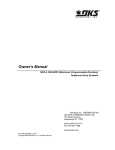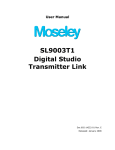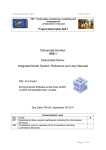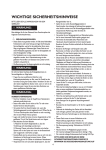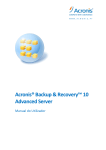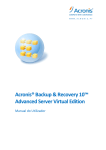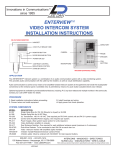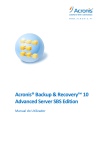Download Standalone User Manual (27-Feb
Transcript
Operator Manual Rev 20140113 Patent Pending Copyright © 2009 CENTROID 159 Gates Road, Howard PA 16841 USA 1 Indexing Controller Operator’s Manual Table of Contents Chapter 1 - Introduction .............................................................................................................. - 5 Interface .................................................................................................................................. - 5 General Specifications ............................................................................................................ - 6 DX1 I/O Expansion Option .................................................................................................... - 6 Electronic Gear Box EGB Option........................................................................................... - 6 Chapter 2 - Setup ........................................................................................................................ - 7 DC System Connections ......................................................................................................... - 7 AC System Connections ......................................................................................................... - 8 AC/DC Common Connections ............................................................................................... - 9 Standard PLC I/O .................................................................................................................. - 10 Auxiliary Input Configurations ............................................................................................. - 11 Auxiliary Inputs Schematic............................................................................................... - 11 Resistor Pack (SIP) Values and I/O Voltage ........................................................................ - 11 Chapter 3 - Operator Panel ....................................................................................................... - 13 Front Panel Display............................................................................................................... - 13 Function ................................................................................................................................ - 13 10-Digit LED Display ........................................................................................................... - 16 Chapter 4 - General Operation .................................................................................................. - 17 Modes of Operation .............................................................................................................. - 17 Power Up .............................................................................................................................. - 17 Homing ................................................................................................................................. - 17 Setting Part Zero Position ..................................................................................................... - 19 Starting, Stopping, and Selecting Programs ......................................................................... - 19 Chapter 5 - Programming.......................................................................................................... - 21 Introduction ........................................................................................................................... - 21 Program Structure ................................................................................................................. - 21 Program Navigation .............................................................................................................. - 21 Program Editing .................................................................................................................... - 22 Inserting program lines ..................................................................................................... - 22 Deleting program lines ...................................................................................................... - 22 Entering M & G Codes ..................................................................................................... - 22 M & G Codes ........................................................................................................................ - 23 Program Examples and Tutorial ........................................................................................... - 25 Demo Program 1 ............................................................................................................... - 25 Program 1 G-Code ............................................................................................................ - 26 Demo Program 2 ............................................................................................................... - 27 Program 2 G-Code ............................................................................................................ - 30 Chapter 6 - Communications .................................................................................................... - 31 Introduction ........................................................................................................................... - 31 Setting up Hyper Terminal.................................................................................................... - 32 Downloading (receiving) Programs ...................................................................................... - 33 How line numbers for programs are determined .............................................................. - 33 Uploading (sending) Programs ............................................................................................. - 33 Errors..................................................................................................................................... - 34 2 Indexing Controller Operator’s Manual Remote Operation ................................................................................................................. - 34 Chapter 7 - Machine Parameters and Configuration................................................................. - 37 How to Access ...................................................................................................................... - 37 Chapter 8 - Error Messages....................................................................................................... - 49 Errors..................................................................................................................................... - 49 - 3 Indexing Controller Operator’s Manual 4 Indexing Controller Operator’s Manual Chapter 1 - Introduction Interface The DX1 can be used with any machine as a rotary axis or linear axis. You can interface with the DX1 by using the input/output cable or RS-232 port methods: a.) Control by Input/Output Cable: The DX1 can be used as a partial 4th axis if hooked up using the input/output cable to a machine that is able to close a relay. This is mostly done using a custom M code. Once the relay is closed the DX1 will receive the signal to start. All indexing commands are stored on the DX1. After the command is finished, the DX1 will send a 250ms pulsed signal to the machine that it is finished. b.) Control by RS-232 Port: The DX1 can be interfaced using the RS-232 port where G and M codes can be sent to the DX1 from a PC. Other information can be sent to the DX1 like programs or updates. The PC can also gather information from the DX1. You can get the position of the motor and tell if it is moving or not. Other information can be sent to the PC like programs or configurations. Note: CENTROID’s multi-axis controls should be specified where direct control of simultaneous interpolated moves is required. 5 Indexing Controller Operator’s Manual General Specifications Input Voltage Input Power Rating Inrush Current Cooling System 100-130VAC or 200-240VAC @50/60Hz Single Phase 15A 25A Internal Cooling Fan Brushed DC Brushed LV* DC Brushless AC 110VDC 48VDC 220 or 110 VAC 12A 12A 12A 22A 22A 22A Over Current, Motor Wiring Fault, Over Load, Over Temp, Encoder Error, Position Error, Communications Error Output Motor Voltage Constant Motor Current Peak Motor Current Circuit Protection and Fault Detection Clamp Solenoid Power Standard Inputs Standard Outputs Serial Port Encoder Input 110 VAC , 0.5 A max 3 Inputs (Cycle Start, Clamp Ack, Home) 2 Outputs (Cycle Finish, Clamp) RS-232, 1 Port, No Flow Control 1 Input, 5v Differential 2 Channel Quadrature with Commutation, EIA RS-422 Internal Brake Resistor (optional) Interrupt on 1A Ground Current 0 to 50˚C -20 to 65˚C 28 lbs 13 ¾” L x 14 ⅛” W x 6 ⅜” H Dynamic Brake Motor Wiring Fault Operating Temperature Storage Temperature Weight Dimensions *Low Voltage DX1 I/O Expansion Option General Purpose Inputs General Purpose Outputs 3 Inputs Opto Isolated 2 Outputs, Open Collector Electronic Gear Box EGB Option Aux Encoder Inputs A,B,Index (differential) 6 Indexing Controller Operator’s Manual Chapter 2 - Setup DC System Connections DX1 DC Back Panel Connections MOTOR ENCODER AND POWER Note: For each motor configuration the connector is rotated on the back panel so the key is in the upright position. PIN FUNCTION A B C D E F G H I J K L M N P R S T U CLAMP OUTPUT (OUT39) CLAMP OUT COMMON +5V OUTPUT (ENCODER) +5V COMMON A /A B /B Z MOTOR SHIELD - MOTOR VOLTAGE + MOTOR VOLTAGE NC HOME INPUT (INP40) /Z EXTERNAL SUPPLY COMMON EXTERNAL SUPPLY CLAMP ACK INPUT (INP37) SHIELD 7 Indexing Controller Operator’s Manual AC System Connections MOTOR POWER PIN A B C D E F G FUNCTION PHSA PHSB PHSC SHIELD CLAMP ACK (INP37) CLAMP OUT CLAMP COM MOTOR ENCODER PIN A B C D E F G H J K L M N P R S T 8 Indexing Controller Operator’s Manual FUNCTION B W /B /W A /A Z /Z +5V COMMON /U V U +5V OUTPUT TO ENCODER /V I/O COMMON HOME INPUT (INP40) SHIELD AC/DC Common Connections INPUTS / OUTPUTS PIN 1 2 3 4 5 6 7 8 FUNCTION CYCLE START INPUT (INP38) EXTERNAL SUPPLY CYCLE FINISH OUT (OUT38) CYCLE FINISH COM NO CONNECTION EXTERNAL SUPPLY COMMON NO CONNECTION NO CONNECTION RS-232 PIN NAME DESCRIPTION 1 2 3 4 5 6 7 8 9 N/C TD RD N/C SG DSR N/C N/C N/C NO CONNECTION TRANSMIT DATA RECEIVE DATA NO CONNECTION SIGNAL GROUND DATA SET READY NO CONNECTION NO CONNECTION NO CONNECTION 9 Indexing Controller Operator’s Manual Standard PLC I/O The DX1 includes 3 isolated inputs (Cycle Start, Home Switch, and Clamp Acknowledge) and 2 fused relay outputs (Cycle Finished, Clamp). The fused power relays are provided for the Rotary Clamp and Cycle Finished signals. The standard I/O configuration requires a sinking device at 5 Volts. If an alternate supply is used the inputs can accept a sinking or sourcing device at 12, or 24 Volts. 10 Indexing Controller Operator’s Manual Auxiliary Input Configurations The standard PLC inputs can also be used with 12 or 24 VDC sensors or switches. The resistor pack (SIP) R85 must be changed to match the input voltage. Sinking or sourcing operation is determined by the wiring configuration as shown below. To enable the optional 12 or 24VDC supply, remove the jumper on J4 between pins 5 and 6. Auxiliary Inputs Schematic Resistor Pack (SIP) Values and I/O Voltage SIP Identification - XXX Indicates Value 4308R-102 -XXX SIP Internal Wiring / Pinout SIP Part Number SIP Resistor Value I/O Voltage 8X – 2 – 471 470Ω 5VDC 4308R – 102 – 102 1.2kΩ 12VDC 4308R – 102 – 222 11 Indexing Controller Operator’s Manual 2.2kΩ 24VDC 12 Indexing Controller Operator’s Manual Chapter 3 - Operator Panel Front Panel Display Key Function Description MODE Used to cycle through Run, Program, Configuration, and Serial communication modes. FIELD SCAN Program navigation. Cycles through fields on a program line. In Run mode, cycles through display options. LINE SCAN UP Program navigation. Moves to previous line in program. LINE SCAN DOWN Program navigation. Moves to next line in program. Repeats if held down. CYCLE START Start a program or continues to the next line in a program when in Run Mode. The controller will remain running a job, unless an error occurs or E-Stop or Cycle Cancel is pressed. 13 Indexing Controller Operator’s Manual CYCLE CANAEL Cancels a running program. Toggles between slow and fast jog rates. LED indicates Slow FAST / SLOW JOG SELECTION jog mode. Press again to select opposite mode. INCREMENTALa/aCONTINUOU S JOG SELECTION Toggles between incremental and continuous jogging. LED indicates Incremental jog mode. Press again to select opposite mode. AXIS JOG BUTTON Jogs left (or CCW) based on speed and jog mode selected. AXIS JOG BUTTON Jogs right (or CW) based on speed and jog mode selected. ZERO ZERO RETURN Sets the Part Zero position to the current location. This value is stored in a parameter and is saved even after power has been removed. Used to set Machine home at powerup. After the axis is homed, this key is used to return to the Machine home position or the Part zero position if one has been set. CLEAR / DELETE Used to discard changes or interrupt communications, or to delete a program line. ENTER / INSERT Used to enter changes, or to insert a line into a program. 14 Indexing Controller Operator’s Manual SELECT M/G CODE Used to toggle between M and G codes when editing or creating a program. NUMERIC KEYPAD Used to enter positions, feed rates, G-codes and other numeric data. Also selects program number. 15 Indexing Controller Operator’s Manual 10-Digit LED Display The 10-digit LED display is divided into three areas in the RUN or PROG modes. Line Number - In run mode, this is the line number that is executing. In program mode, this is the line that is being displayed or edited. In config mode, this is the parameter number that is being displayed or edited. Data Type - A letter indicating the type of data being displayed* G M P A F L Data – G-code Field (in PROG mode only). – M-code Field (in PROG mode only). – Current Position (in RUN mode only) – Programmed Axis Position – Feedrate or other field 3 data. – Programmed Loop Count. In RUN mode this indicates the number of loops remaining. - The indicated or programmed data. *In other modes, or under certain error conditions, these fields may vary. 16 Indexing Controller Operator’s Manual Chapter 4 - General Operation Modes of Operation RUN PROG N CONFIG SERIAL The MODE button on the front panel is used to cycle through the modes of operation shown above. The MODE key is disabled when running a program or during a serial upload or download. After power up, the control is in RUN mode by default. RUN mode is used to run a program, jog, home, or set zero. If a program is being executed, the line number section of the display will indicate the line number. While in run mode, the LED display will be steady. If a program is not being executed, the line number section of the display will be blank. PROG mode is used to select a program, display a program, or edit a program. While in PROG mode, the line number section will blink. See Chapter 5 for more information. CONFIG mode is used to display and edit control parameters. information. See Chapter 7 for more SERIAL mode is used to upload/download programs, update firmware, and to enter remote serial mode. See Chapter 6 for more information. Power Up Press the on-off rocker switch to the “ON” position to turn the control on. The LEDs will briefly display “CENTROID”. If there are errors encountered during the initialization process, they will be displayed. See Chapter 7 for more detailed information. After successful initialization with the E-stop released, the display will indicate that the home position has not been set, by flashing “NOT HOMED” as indicated below. Homing After power up of the control, home is set by pressing the ZERO RETURN key*. The display will show the following message: 17 Indexing Controller Operator’s Manual After homing, the display will indicate the current position, which will be 0.0 unless the part zero position has been set. Home can be set using one of the following three methods: Home Switch - This method of homing uses a normally closed switch in conjunction with the index pulse from the encoder. The axis will move at the slow-jog rate until it reaches the home switch**. It will then reverse direction until the encoder index pulse is located. Reference Mark - This method of homing uses the manual jog controls to position the axis at a predetermined location before the homing sequence is initiated. The axis moves at the slow-jog rate until the encoder index pulse is detected**. A typical reference mark is shown below. Jog - This method of homing sets the home position to wherever the current position of the axis is. The axis position is established by manually jogging to the desired location. The encoder index pulse is not used with this homing method and is therefore not an easily repeatable homing method. *If parameter 7 is set to 1.0, the control will automatically start the homing procedure after initialization. The automatic homing will only work if the control is powered up with the E-stop released and there are no errors during initialization. **The direction in which the axis moves to find the home position is determined by parameter 9. The Slow-Jog rate is determined by parameter 18. 18 Indexing Controller Operator’s Manual Setting Part Zero Position Zero is initially set at the home position. To manually set the Part Zero position, jog the axis to the desired position and then press and hold the ZERO SET key for 3 seconds. This will cause the position display to read 0.0000 and the machine parameters will store the offset from the home position. Once part zero has been set, the ZERO RETURN key will return the axis to the part zero position Starting, Stopping, and Selecting Programs After a successful homing, the last program that was running before power off will be loaded. To load a different program number, press the MODE key until the display reads “PROG N”, where N is a digit 0-9 indicating the currently selected program number. Select a different program by using the numeric keypad. Pressing the CYCLE START key or triggering the external START input will cause the first program line to be executed. When the move is complete, the FINISH output relay will be turned on for 250ms and then turned off. The control will then be ready to execute the second line of the program. After the last line of the program is executed it will restart. To stop a running program, press CYCLE CANCEL or E-STOP. If the CYCLE START key is pressed after a program is cancelled, the program will start over from line 1. 19 Indexing Controller Operator’s Manual 20 Indexing Controller Operator’s Manual Chapter 5 - Programming Introduction The indexing controller can store 10 different programs, numbered 0–9, each composed of up to 99 lines, numbered 1-99. Press the MODE key until the display reads “PROG N”, where “N” is 0-9. Pressing 0-9 selects another program and the display will change to indicate the current selection. To clear the entire selected program, hold down the CLEAR / DELETE key for three seconds while the display reads “PROG N”. “PROG CLR” will flash for three seconds to acknowledge the operation. When the selected program is cleared, all program lines will be set to the default: G91 A0.000 Fmax L1 (Where max indicates the rate specified in parameter 13) To display or edit the selected program when the display reads “PROG N”, press the ENTER / INSERT, LINE SCAN UP, or LINE SCAN DOWN keys. When in the display or edit state, the line number section of the display will blink. Program Structure The program lines are structured in a table-like style that closely resembles a line of industry standard G-code such as N01 G90 A1.234 F100 L1. Each line is composed of at least one field and at most four fields depending upon the particular operation (M or G code). Line 01 02 03 … 99 Field 1 M/G code 90 91 99 … 99 Field 2 Angle/Position 1.234 90.000 000.000 … 000.000 Field 3 Feedrate 100.000 100.000 1.0 … 1.0 Field 4 Loop Count 1 1 1 … 1 Program Navigation The FIELD SCAN key is used to cycle through the program fields. Navigation will wrap around to the first field. The current field is indicated by the letter (M/G/A/F/L) displayed in section 2 of the LED display. 21 Indexing Controller Operator’s Manual The LINE SCAN UP and LINE SCAN DOWN keys are used to change the line number of the program. The current program line number is always displayed in section 1 of the LED display. Field 1 is always used and will contain an M or G code number. Fields 2-4 may or may not be used depending upon the particular M or G code. If fields 2-4 are unused for a particular M or G code, the FIELD SCAN key navigation key will skip that field. Program Editing To edit data in a field use the numeric keypad to enter new data. When the first valid character is typed, the LED display will clear section 3 and the character will appear in the leftmost position with an underscore '_' character to the right. As more characters are entered, they will appear on the LED display. When the character limit is reached, no more characters can be entered. Press the CLEAR / DELETE key to discard any changes. Use the ENTER / INSERT key to accept the new data and remain in the same field. Use the program navigation keys to accept the new data and move to another field. If the data entered is invalid, the display will blink “BAD DATA” until the CLEAR / DELETE key is pressed. After the ENTER / INSERT key is pressed, the change will be discarded. Inserting program lines While in program display mode, hold the ENTER / INSERT key for 3 seconds. The display will flash “LINE INS” for three seconds to acknowledge the operation. All lines from the current line to line 98 are moved down one line. A default program line is inserted. Subprogram (M98) lines are automatically renumbered. Deleting program lines While in program display mode, hold the CLEAR / DELETE key for 3 seconds. The display will flash “LINE DEL” for three seconds to acknowledge the operation. All lines from the next one until line 99 are moved up one line. Line 99 is set to a default program line. Subprogram (M98) lines are automatically renumbered. Entering M & G Codes While in the M&G code field, use the SELECT M/G CODE key on the numeric keypad to toggle between M and G and the digits 0-9 to enter the desired code. Valid M&G codes are: 22 Indexing Controller Operator’s Manual M & G Codes G4 Dwell - Pause execution for the time specified. Field 2 (unused) Field 3 (Time) --0.001 – 9999.999 seconds Field 4 (Loop Count) 1-65535 G90 Absolute position – moves the axis to an absolute position at the specified rate. The loop count field is invalid since repeating a move to an absolute position causes no movement. For rotary applications, the sign of the position determines the direction the motor will move, with positive values indicating CW movement and negative values indicating CCW movement. Notice that it is possible to enter a negative zero to perform a CCW move to the zero position. Field 2 (Position) Field 3 (Feedrate) Field 4 –359.999 to +359.999 0.001 – 9999.999 --G91 Incremental position – moves the axis an incremental distance at the specified rate. The sign of the number determines the direction. The loop count determines the number of times the line will be repeated. Field 2 (Position) Field 3 (Feedrate) Field 4 (Loop Count) –359.999 to +359.999 0.001 – 9999.999 1-65535 G94 Continuous mode – When this line is executed, the following lines are executed continuously without waiting for CYCLE START signals, until the end of program or a G95 line. Fields 2-4 are not used. G95 Step Mode – When this line is executed, the control is placed into step mode. This is mainly used to transition out of continuous mode. Fields 2-4 are not used. M10 Turn clamp on. M11 Turn clamp off. These functions control the rotary table clamp. By default, the clamp is off. Programs must explicitly use these functions to control the clamping. M26 Set zero position. Executing this line has the same effect as using the ZERO SET key. Fields 2-4 are not used M60 Initialize and Start Data Logging – This is used as a tool for tuning the motor in conjunction with M63. There are several sets of data gathered which are similar to the Centroid data gathers. The ones that should be used are Profiles 0 and 9. Profile 0 is for position related information and is used most of the time whereas Profile 9 is for current information and is rarely used. Select the number of samples to collect based on how long of a time should be recorded. The Sample Rate determines how often the information is recorded. A value of 1 stores information every time, a value of 2 stores information every other time and so on. The information is logged at 16kHz which is fine for the current information, but the position data only changes at ¼ that rate so data only needs to be recorded every 4 times. The recommended 23 Indexing Controller Operator’s Manual settings for a Profile 0 gather are M60 A0 F8000 L4. This will gather Profile 0 for 2 seconds. The recommended settings for a Profile 9 gather are M60 A9 F32000 L1. This will gather Profile 9 for 2 seconds. To send the data up to a PC, M63 must be called. Field 2 (Profile) Field 3 (Samples) Field 4 (Sample Rate) 0, 9 1 – 32000 1-65535 M63 Send DataLog to PC – Send the collected data back to the PC over the serial port. The information gathered will be sent over the serial port as setup in the Config menu. As soon as this M-Code is called the data transfer begins, so the PC must be setup to receive the data before the program is run. The details on how to set that up are in Chapter 6. The Samples and Sample Rate are defined the same as in the M60 except that they act on the data that was gathered. The recommended settings are M63 A0 F8000 L1. If the setup was followed for M60 Profile 0 gather then this will send all the data gathered. Field 2 (unused) Field 3 (Samples) Field 4 (Sample Rate) --1-32000 1-65535 M91 Find Home Minus– This code causes the motor to move in the negative (CCW) direction until the Home switch input is closed. The motor then backs off until in the positive direction until an index pulse is detected and then stops. M92 Find Home Plus– This code causes the motor to move in the positive (CW) direction until the Home switch input is closed. The motor then backs off until in the negative direction until an index pulse is detected and then stops. M94 Turn on bit M95 Turn off bit These functions turn on (M94) or turn off (M95) memory bits MEM101-MEM116. Field 2 Field 3 Field 4 (plc MEM bit) ----1-16 M98 Subprogram call/jump – causes execution to jump to the line specified. Line 99 is not valid since it leaves no room for a M99 return. Field 2 Field 3 (line) Field 4 (loop count) --2-98 1-65535 M99 Subprogram return/end of program. When this command is executed, it will either end program execution or return from the previous M98 call. If an M98 was executed previously, execution returns to the line from which it was called- either to execute another step of the loop count or continue to the next program line. Nesting of subprograms is allowed up to a depth of 16. No other fields are valid. M100 Wait for input open M101 Wait for input close Field 2 --- Field 3 --- Field 4 (plc Input bit) 1-256 24 Indexing Controller Operator’s Manual Program Examples and Tutorial This is a step-by-step example of how to program M and G codes on the indexing controller. First thing is to clear the current program. Press the MODE key until the display reads “PROG N”, where “N” is 0-9. Press the 1 key to select program 1. Hold down the CLEAR / DELETE key for three seconds while the display reads “PROG CLR.” This will flash for three seconds to acknowledge the operation. When the selected program is cleared, all program lines will be set to the default. Demo Program 1 This program will move 90 degrees every time cycle start is press until it reached 360 degrees. 1 - Press the MODE key until you see “PROG N” where N is the program number. Press the 1 key (or any program number you wish to use). Your screen should look something like this “PROG 1” at which point you press the ENTER / INSERT key to accept. 2 - When “01 G91” is displayed, press the FIELD SCAN key to move to the position field. 3 –“01 A0.000” will be display. Press the 9 key then the 0 key and press the ENTER / INSERT key. “01 A90.000” will be displayed. 4 - Press the FIELD SCAN key to move to the feedrate field. “01 F80.000” will be displayed. 5 - Press the FIELD SCAN key to keep the current value and move to the loop field. “01 L1” will be displayed. Press the 4 key so “01 L4” is displayed. 6 - Press the FIELD SCAN key to move back to the M and G Code field. Press the LINE SCAN DOWN key to move to line 2. 25 Indexing Controller Operator’s Manual 7 -”02 G91” will be displayed. Press the SELECT M/G CODE key. “02 M_” will be displayed. Press the 9 key twice so “02 M99_” is displayed and press the ENTER / INSERT key. 8 - Press the MODE key to save the program and press the CYCLE START key to run the program. Program 1 G-Code 01 G91 A90 F80 L4 ; Rotates motor 90 degrees, 4 times, giving 360 degrees of rotation. 02 M99 ; Ends program. 26 Indexing Controller Operator’s Manual Demo Program 2 This program is a demo of the most common M & G Codes used in a typical program. Clear another program number as described above. Select that program number and continue typing the following. 1. The first move is a G91 which is default after clearning a program. Press the FIELD SCAN key to move to the position field and type 45 to move 45 degrees. Press the FIELD SCAN key again, type 50 for a feedrate of 50. Now press the FIELD SCAN key and type 4 to loop 4 times. Press the FIELD SCAN key one last time to move back to M&G code field. 2. Press the LINE SCAN DOWN key to move to line 2. Type 90 for G90; press the FIELD SCAN key and type –0 for position. Press the FIELD SCAN key to move to the feedrate field and type 80, and then press the FIELD SCAN key to cycle back to the first field. 3. Press the LINE SCAN DOWN key to move to line 3. Default G91 press the FIELD SCAN key and type 30 for position. Press the FIELD SCAN key and enter 60 for a feedrate, press the FIELD SCAN key to move to the loop field and type 6. Press the FIELD SCAN key again to move back to M&G code field. 27 Indexing Controller Operator’s Manual 4. Press the LINE SCAN DOWN key to move to line 4. Press the SELECT M/G CODE key. This will change the G to an M. Type 26 for M26. 5. Press the LINE SCAN DOWN key to move to line 5. Type 94 for G94. 6. Press the LINE SCAN DOWN key to move to line 6. Press the SELECT M/G CODE key. Type 98 for M98. Press FIELD SCAN key and type 10 for line 10. Press the FIELD SCAN key to move to the loop field and type 12. Press the FIELD SCAN key again to move back to M&G code field. 7. Press the LINE SCAN DOWN key to move to line 7. Type 95 for G95. 8. Press the LINE SCAN DOWN key to move to line 8. Type 90 for G90; press the FIELD SCAN key and type 270 for position. Press the FIELD SCAN key to move to the feedrate field and type 80, and then press the FIELD SCAN to cycle back to the first field. 9. Press the LINE SCAN DOWN key to move to line 9. Press the SELECT M/G CODE key. Type 99 for M99. 28 Indexing Controller Operator’s Manual 10. Press the LINE SCAN DOWN key to move to line 10. Default G91 press the FIELD SCAN key and type 15 for position. Press the FIELD SCAN key and enter 90 for a feedrate, press the FIELD SCAN key to move to the loop field and type 1. Press the FIELD SCAN key again to move back to M&G code field. 11. Press the LINE SCAN DOWN key to move to line 11. Type 04 for G04; press the FIELD SCAN key and type 2 for a 2 second delay. Press the FIELD SCAN key to move to the loop field and type 1. Press the FIELD SCAN key again to move back to M&G code field. 12. Press the LINE SCAN DOWN key to move to line 12. Press the SELECT M/G CODE key for M99. 13. Press the MODE key until you get to the RUN menu and press the CYCLE START key. 29 Indexing Controller Operator’s Manual Program 2 G-Code 01 G91 A45 F50 L4 02 G90 A-0 F80 03 G90 A30 F60 L6 04 M26 05 G94 06 M98 F10 L12 07 G95 08 G90 A270 F80 09 M99 10 G91 A15 F90 L1 11 G04 F2 L1 12 M99 ; Rotates motor 45 degrees, 4 times, giving 180 degrees of rotation. ; Rotates the motor CCW to 0. ; Rotates motor 30 degrees, 6 times, giving 180 degrees of rotation. ; Sets the zero position ; Following lines will be in continuous mode. ; Calls up a sub program on line 10 and executes it 12 times. ; Following lines will be in step mode. ; Rotates the motor to 270 degrees. ; End program ; Sub program. Rotates motor 15 degrees. ; Subprogram. Pauses 2 seconds. ; End of Sub Program. 30 Indexing Controller Operator’s Manual Chapter 6 - Communications Introduction The indexing controller provides serial communication via the 9-pin serial port connection located on the back panel. The serial interface can be used to upload or download programs, provide remote control, and update control software through HyperTerminal in Windows. The serial communications operate at speeds from 1200 to 115200 baud. The default serial communication parameters are 115200 baud, 8 data bits, no parity, 1 stop bit, and no flow control. See Chapter 6 – Machine Parameters and Configuration for details on setting baud rates, parity, stop bits, and other communications related settings. SERIAL DNLOAD N UPLOAD N REMOTE The controller must be in the Serial mode to send and receive data. Press the MODE key until the display reads “SERIAL” then press the ENTER / INSERT key. Once in Serial mode, use the FIELD SCAN key to cycle through “DNLOAD N”, “UPLOAD N”, and “REMOTE”. The N indicates which program number will be received (download) or sent (upload). Use the numeric keypad to change the program number. Press the ENTER / INSERT key (or line scan down) to enter the DNLOAD, UPLOAD, or REMOTE serial mode. Serial upload and download can be canceled by pressing the MODE, CLEAR / DELETE, CYCLE START, or CYCLE CANCEL keys. 31 Indexing Controller Operator’s Manual Setting up Hyper Terminal To access Hyper Terminal go to the start menu and click on All Programs, Accessories and then Communications. A window may come up and prompt you if you want to use Hyper Terminal as the default telnet program. Click No unless you want to use Hyper Terminal as the default telnet program. Enter a name for your connection and select an icon. Select which COM port you are using and click OK. Select which port settings you are using. The following are the default settings. See Chapter 6 if you wish to change your port settings. To set up Hyper Terminal properly to work with the indexing controller, go to File then Properties. Click on the Settings tab then on the ACSII Setup button. Make sure “Send line ends 32 Indexing Controller Operator’s Manual with line feeds” and “Echo typed characters locally” are checked. Click OK to exit the ASCII Setup and OK again to exit the Properties. Hyper Terminal is now set up and ready to go. Downloading (receiving) Programs To download a program select “DNLOAD N” where N is the program number. Press the ENTER / INSERT key, the display will indicate “DN WAITING” until the start of receiving characters. To start sending a program in Hyper Terminal click on Transfer then Send Text File. Open the program you wish to send. After the first character is received, the display changes to “DN nnnnnnnn”, where nnnnnnnn indicates the count of characters received. The end of the download is determined after 250ms (¼ second) of not receiving data, or on an error condition. How line numbers for programs are determined If a line is downloaded and it contains a line number in the format Nnn, then nn is the line number where the downloaded program line is stored. If there is no N specified on a line, then the line number is automatically incremented by one. Uploading (sending) Programs To upload a program Field Scan until “UPLOAD N” is displayed, where N is the program number. To receive a program in Hyper Terminal click on Transfer then Capture Text. It will prompt you for a destination to save the file. Click on Browse, choose a destination, and enter a file name. Click on Save then Start. On the indexing controller press the ENTER / INSERT key the display will indicate “UP nnnnnnnn”, where nnnnnnnn indicates the count of characters received. 33 Indexing Controller Operator’s Manual The format for receiving a program is similar to the format when in programming mode. Each line must contain all data relevant to the particular M & G code. N numbers are optional: each received line is placed at the next available line number, starting at line 01 and going no further than line 99. Programs exceeding 99 lines are truncated. Errors Several errors can occur during a serial download. NN indicates either the program line number where the error occurred, or the line number of the last successfully parsed line. Error trying to parse a single line. After the program was received, it was not valid. A single line exceeded the maximum length (over ~1000 characters). The program line number has exceeded the maximum (99). G91 K34 (Results in a PARS error because of the 'K') G45 A12 F10 (Results in a validation error because G45 is not a valid G-code). Remote Operation Remote operation is used to send commands to the indexing controller from a computer via RS232. Once in serial mode use, the FIELD SCAN key to cycle to remote and press the ENTER / INSERT key to start. The following G,M,A,F,L fields can be sent a line at a time or there may be more than one field present on the same line. The order of fields and whether they are sent separately, or together, is unimportant. Gnn Mnn Addd.ddd Fddd.ddd Lddddd G-code command to be stored in field 1. M-code command to be stored in field 1 Axis position to be stored into field 2 (first axis) Feedrate or other data to be stored in field 3. Loop count or other data to be stored in field 4. 34 Indexing Controller Operator’s Manual The following commands are used: E – execute the above fields. The controller will respond with one of the following: “OK” The line does not have errors and is being executed. “INVALID LINE” The line contained invalid data. No movement. “ERROR: EXECUTING PREVIOUS COMMAND” X – stops a command – The controller will respond with the following: “CANCELED” The previous line executed was canceled. S – status – The controller will respond with one of following: “MOVING Axxx.xxx” The controller is executing a command. xxx.xxx indicates the current position. “STOPPED Axxx.xxx” The motor is not moving. xxx.xxx indicates the current position. DC – dump Machine Parameters and Configuration The machine configuration is uploaded. DPn - dump program number n (0-9). The specified program number is uploaded. “DUMP PROG INVALID NUMBER” “UNKNOWN COMMAD” - for unrecognized commands. Downloading Parameter File To download your configuration or parameter file, connect to your PC with a serial cable or serial USB port. Make sure hyperterminal or whatever software you are using is setup with 115200 baud, 8, none, and 1. Then send the command DC followed by Enter. Save the file, then send DCREPORT and save that file. The DCREPORT will download your parameter file. 35 Indexing Controller Operator’s Manual 36 Indexing Controller Operator’s Manual Chapter 7 - Machine Parameters and Configuration How to Access To access the machine configuration parameters, press the MODE key until the display reads “CONFIG” then press the ENTER / INSERT, LINE SCAN UP, or LINE SCAN DOWN keys. Some of the configuration parameters are protected and cannot be changed unless the “PASSWORD” parameter is set correctly. If a value is protected, the display will read “PROTECTED” while a keypad key is held down. Use the Line Scan navigation keys to scroll through the parameter numbers. The line scan keys will repeat if held down. Use the Field Scan key to switch the display between the parameter description and the parameter value. Values can be changed when in the parameter value display field. To edit a value, use the numeric keypad to enter a new value and press the ENTER / INSERT key to accept. Press the CLEAR / DELETE key to discard changes. If invalid data is entered, the display will flash “BAD DATA” until the CLEAR / DELETE key is pressed. Parameter 00 – System Serial Number (SERIALNO) This parameter is the systems serial number. This is used to identify the DX1 with Technical support and is a read-only parameter. Parameter 01 – Software Revision (REVISION) This parameter is the systems software revision number. It is a read-only parameter and can only be changed by a firmware update. Parameter 02 – Programmable Logic Revision (LOGICVER) This parameter displays the logic firmware revision. It is a read-only parameter. Parameter 03 – Supervisor Password (PASSWORD) When the correct password value is entered this parameter allows protected parameters to be changed. A warning is displayed if an attempt to change a protected parameter occurs. 37 Indexing Controller Operator’s Manual Parameter 04 – Read-Only Programs (READONLY) When this parameter is set to 1.0, programs cannot be edited or over written by a serial download or from the Program menu. The default value of 0 allows full read and write access to the programs. Parameter 05 – Application Type (APP_TYPE) This parameter affects how rates and positions are interpreted. The default value of 0 treats the DX1 as a rotary application so the display will wrap around at 360 to 0. Setting this parameter to 1 puts the DX1 in linear mode where the display goes +/- as far as the display allows based on Parameter 6. Parameter 06 – Display Format (DISP_FMT) These settings determine how the position is displayed. Rotary Application (Parameter 05 = 0) Value Display Description 0 ddd Rotary decimal degrees 1 ddd.d Rotary decimal degrees 2 ddd.dd Rotary decimal degrees 3 ddd.ddd Rotary decimal degrees 4 ddd.dddd Rotary decimal degrees 5 ddd.mm.ss Rotary degrees, minutes, seconds Linear Application (Parameter 05 = 1) Value Display Description 0 sdddddd s - Sign (+/-), d - Digit 1 sddddd.d s - Sign (+/-), d - Digit 2 sdddd.dd s - Sign (+/-), d - Digit 3 sddd.ddd s - Sign (+/-), d - Digit 4 sdd.dddd s - Sign (+/-), d - Digit 5 sd.ddddd s - Sign (+/-), d - Digit Parameter 07 – Auto Home (AUTOHOME) The control will automatically execute the homing procedure upon power up, provided the Estop is released and there are no other faults. The default value of 0 will not automatically home the DX1 while a value of 1 will home the DX1 as described above. A supervisor password is required to change the value. DO NOT change this parameter without contacting your dealer. 38 Indexing Controller Operator’s Manual Parameter 08 – Machine Home Type (HOMETYPE) This parameter is used to set the homing type. See the chart below for allowed values. A supervisor password is required to change the value. DO NOT change this parameter without contacting your dealer. Value 0 1 2 Type Home Switch Jog Reference Mark Description Move to home switch and back off to index pulse Home is set to current location Jog to reference mark and homes to the index pulse Parameter 09 – Homing Direction (HOME_DIR) This parameter is used to set the direction in which the DX1 homes. Value 0 1 Description Positive Direction Negative Direction Parameter 10 – Auto Restart (AUTOSTRT) This parameter determines whether a program will automatically restart when it finishes. With auto restart on, a program will move to the first line of the program after the last non-M99 line is executed. When auto restart is off, the program does not automatically start again with a Cycle Start key press required. Value 0 1 Function Auto Restart Off Auto Restart On Parameter 11 – Serial Communication Baud Rate (BAUDRATE) This parameter is the baud rate for serial communication. Can be set to 1200, 2400, …, 115200. The default value is 115200. Parameter 12 – Serial Communication Data Bits (DATABITS) This parameter is the number of data bits for the serial communication. The value can be either 7 or 8. 39 Indexing Controller Operator’s Manual Parameter 13 – Serial Communication Parity (PARITY) This parameter is for the parity of the serial communication. The default value is 0. Value 0 1 2 Parity None Odd Even Parameter 14 – Serial Communication Stop Bits (STOPBITS) This parameter is for the stop bits of the serial communication. Values can be either 0, 1, or 2. Parameter 15 – Motor Revolutions Per Unit (MOTORTPU) This parameter specifies the number of motor revolutions per unit. If P05 = 0 (Rotary), the units are revolutions. For example, if 90 revolutions of the motor shaft result in one revolution of the rotary table, then this parameter would be set to 90. If P05 = 1 (Linear), the units are inches, or millimeters, as desired. For example: If 5.0800 turns of the motor shaft result in 1.0000 inch of travel, enter 5.08 so positions are interpreted as inches and rates are inches/min. If 0.2000 turns of the motor shaft result in 1.000 mm of travel, enter 0.2000 so positions are interpreted as mm and rates are mm/min. A supervisor password is required to change the value. DO NOT change this parameter without contacting your dealer. Parameter 16 – Encoder Counts Per Revolution (ENCDRCNT) This parameter is the number of encoder counts per revolution of the encoder mounted on the motor. Values can range from 1-99999999. A supervisor password is required to change the value. DO NOT change this parameter without contacting your dealer. Parameter 17 – Direction Reversal (DIR_REVS) Direction reversal is only used when the motor moves correctly, but in the wrong direction compared to the jog keys. This may be necessary to change due to motor mounting. A supervisor password is required to change the value. DO NOT change this parameter without contacting your dealer. Value 0 1 Description No direction Reversal Motor direction reversed 40 Indexing Controller Operator’s Manual Parameter 18 – Slow Jog Rate (SLOW_JOG) This parameter sets the slow jog rate. It is displayed in degrees per second or in/mm per minute. Parameter 19 – Fast Jog Rate (FAST_JOG) This parameter sets the fast jog rate. It is displayed in degrees per second or in/mm per minute. Parameter 20 – Max Rate (MAX_RATE) This parameter sets the max rate. It is displayed in degrees per second or in/mm per minute. A supervisor password is required to change the value. DO NOT change this parameter without contacting your dealer. Parameter 21 – Positive Software Travel Limit (POSLIMIT) This parameter defines the positive travel limit that the DX1 software will allow. When both parameter 21 & 22 are set to zero (default), there are no active software limits. If either parameter is changed from its default value (zero), both positive and negative travel limits are enforced. The DX1 must be powered down and restarted for these changes to take effect. Parameter 22 – Negative Software Travel Limit (NEGLIMIT) This parameter defines the negative travel limit that the DX1 software will allow. When both parameter 21 & 22 are set to zero (default), there are no active software limits. If either parameter is changed from its default value (zero), both positive and negative travel limits are enforced. The DX1 must be powered down and restarted for these changes to take effect. Parameter 23 –Jog Increment 1 (JOG_INC1) This parameter holds first jog increment value. For rotary applications the default value for this parameter is 0.01°. For linear applications the default value is 0.0001”. To select this jog increment, when in RUN mode, press the 1 key on the numeric keypad. The jog increment will be displayed while the button is held down. Parameter 24 –Jog Increment 2 (JOG_INC2) This parameter holds second jog increment value. For rotary applications the default value for this parameter is 0.1°. For linear applications the default value is 0.001”. To select this jog increment, when in RUN mode, press the 2 key on the numeric keypad. The jog increment will be displayed while the button is held down. 41 Indexing Controller Operator’s Manual Parameter 25 –Jog Increment 3 (JOG_INC3) This parameter holds third jog increment value. For rotary applications the default value for this parameter is 1°. For linear applications the default value is 0.01”. To select this jog increment, when in RUN mode, press and hold the 1 key on the numeric keypad. The jog increment will be displayed while the button is held down. Parameter 26 – Part Zero (PARTZERO) This parameter records the offset from the axis home position to the local part zero position. This value is updated using the ZERO SET or M26 commands. Parameter 27 – Clamp Control (CLMPCTRL) This parameter is a combination of settings that affect the clamp control. The default value of 0 will enable the clamp output and clamp input signals. A supervisor password is required to change the value. DO NOT change this parameter without contacting your dealer. Bit 0 1 2 3 Function Ignore All Invert Output Invert Input Ignore Input Parameter Value Add 1 Add 2 Add 4 Add 8 Parameter 28 – Automatic Clamp (AUTOCLMP) This parameter is for applications where a clamp is being used. When this parameter is set to zero and CLMPCTRL is enabled, the DX1 will automatically unclamp before any kind of move is executed and then re-clamp after the move is completed. This includes movements during program execution as well as jogging in Run mode. When this parameter is set to 1, and the DX1 is homed, the clamp will be released and will remain unclamped until commanded manually or under program control. Parameter 29 – Current Program Number (PROG_NO) This parameter holds the current program number. 42 Indexing Controller Operator’s Manual Parameters 30 – 52 These parameters require a supervisor password to change the value. DO NOT change these parameters without contacting your dealer. Parameter # 30 31 32 33 34 35 36 37 38 39 40 41 42 43 44 45 46 47 48 49 50 51 52 Name KP_POS KI_POS KD_POS KV1 KG KA ACCEL MTRPOLES DRV_CUR DRV_ANGL KP_CUR KI_CUR KD_CUR FF_FIXED FF_RPM INTERPF IL_POS IL_CUR PID_FILT KP_HOLD KI_HOLD KD_HOLD PIDFHOLD Description Position Proportional Gain Coeff. Position Integral Gain Coeff. Position Derivative Gain Coeff. Slow Jog Power Coeff. Gravity Offset Power Coeff. Acceleration Power Coeff. Seconds to reach max speed Motor Poles Drive Current Drive Angle Current Proportional Gain Coeff. Current Integral Gain Coeff. Current Derivative Gain Coeff. Feed Forward Fixed Coeff. Feed Forward RPM (Volts/1000 RPM Gain Coeff.) Interpolation Factor Position Integral Windup Limit Current Integral Windup Limit PID Filter Kp at Hold Ki at Hold Kd at Hold PID Filter at Hold 43 Indexing Controller Operator’s Manual DX1 PID Settings Parameters Name P30 KP_POS P31 KI_POS P32 KD_POS P33 17” lb. In 5C 750W Leedan 29” lb. 1kW 2kW 750W RT150 750W RT200 1kW RT250 2kW RT320 0.01 0.015 0.015 0.015 0.015 0.03 0.02 0.015 0.015 0.00006 0.00006 0.00006 0.00006 0.00006 0.00006 0.00006 0.00006 0.00006 0.15 0.2 0.03 0.2 0.2 0.05 0.05 0.2 0.2 KV1 0 0 100 100 125 100 150 150 100 P34 KG 0 0 0 0 0 0 0 0 0 P35 KA 100 200 75 150 150 0 0 100 150 P36 Accel 0.5 0.6 0.5 0.5 0.6 0.5 0.5 0.5 0.6 P37 MTRPOLES 0 0 8 8 8 8 8 8 8 P38 DRV_CUR 50 90 53 75 100 53 53 50 100 P39 DRV_ANGL 5 5 5 5 5 5 5 5 5 P40 KP_CUR 2 2 2 2 2 2 2 2 2 P41 KI_CUR 0.000006 0.000006 0.000006 0.000006 0.000006 0.000006 0.000006 0.000006 0.000006 P42 KD_CUR 2 2 2 2 2 2 2 2 2 P43 FF_Fixed 0.25 0 0.25 0.25 0.25 0.25 0.25 0.25 0.25 P44 FF_RPM 0.1 0 0.1 0.1 0.1 0.1 0.1 0.1 0.1 P45 INTERPF 10 10 10 10 10 10 10 10 10 P46 IL_POS 32768000 32768000 32768000 32768000 32768000 32768000 32768000 32768000 32768000 P47 IL_CUR 32768000 32768000 32768000 32768000 32768000 32768000 32768000 32768000 32768000 P48 PID_Filter 1 1 1 1 1 1 1 1 1 P49 KP_HOLD 0.01 0.015 0.015 0.01 0.01 0.001 0.005 0.01 0.015 P50 KI_HOLD 0.00006 0.00006 0.00006 0.00006 0.00006 0.00006 0.00006 0.00006 0.00006 P51 KD_HOLD 0.03 0.1 0.04 0.04 0.1 0.001 0.03 0.01 0.015 P52 PIDFHOLD 1 1 1 1 1 1 1 1 1 44 Indexing Controller Operator’s Manual Parameter 53 – Stall Detection (STALLDET) This parameter is used to disable stall detection. Set the parameter to 1 to disable stall detection. The default value of 0 enables stall detection and should normally never be changed. A supervisor password is required to change the value. DO NOT change this parameter without contacting your dealer. For v3.12+, a value of 2 will disable only differential encoder errors, a value of 4 will disable only quadrature encoder errors, and a value of 6 will disable them both. Parameter 54 – Input Debounce Time (DEBOUNCE) This parameter is used to set the debounce time used for all inputs. The time is in milliseconds. Integer millisecond values from 0 to 100 may be entered in this parameter. A supervisor password is required to change the value. Parameter 55 – Slaved Motor Revolutions Per Unit (MTRTPU2) This parameter is used for the slaving EGB option. A supervisor password is required to change the value. DO NOT change this parameter without contacting your dealer. Parameter 56 – Slaved Encoder Counts Per Revolution (ENCDR2) This parameter is used for the slaving EGB option. A supervisor password is required to change the value. DO NOT change this parameter without contacting your dealer. Parameter 57 – Slaved Ratio Numerator (S_RATIO1) This parameter is used for the slaving EGB option. A supervisor password is required to change the value. DO NOT change this parameter without contacting your dealer. Parameter 58 – Slaved Ratio Denominator (S_RATIO2) This parameter is used for the slaving EGB option. A supervisor password is required to change the value. DO NOT change this parameter without contacting your dealer. Parameter 59 – Enable Scale Feedback (EN_SCALE) Set this parameter to 1 to enable the scale feedback system. This parameter must be set to make the other parameters take effect. Disable scale feedback by setting this parameter to 0. Zero is default. A supervisor password is required to change the value. DO NOT change this parameter without contacting your dealer. 45 Indexing Controller Operator’s Manual Parameter 60 – Display Encoder Position (ENC_DISP) This parameter is 0 by default which displays the motor encoder position based on parameters 5, 6, 15, 16, and 17. When set to 1 the Scale encoder position will be displayed based on parameters 5, 6, 61, 62, and 63. A supervisor password is required to change the value. Parameter 61 – Scale Encoder Counts Per Rev (SC_COUNT) Enter the number of counts per revolution on the scale encoder. Remember to take quadrature into account. If the encoder is 2000 lines or ppr then enter 8000. A supervisor password is required to change the value. DO NOT change this parameter without contacting your dealer. Parameter 62 – Scale Encoder Revs per Unit (SC_TPU) The number of revolutions of the scale encoder per unit of measurement is set with this parameter. The units do not matter as long as this is setup correctly. If the encoder turns once for each degree then put 1 in this parameter. If the encoder turns 15 times per inch, then put 15 in this parameter. If a linear scale is used then put 1 in this parameter and put the total number of encoder counts per unit in parameter 61. A supervisor password is required to change the value. DO NOT change this parameter without contacting your dealer. Parameter 63 – Scale Encoder Direction Reversal (SCDIRREV) Direction reversal is only used when the scale module works correctly, but displays the wrong direction compared to the jog keys. This may be necessary to change due to the mounting setup. The default is counting negative when the encoder turns CW. This will not affect the interaction between the scale and motor encoders. If they are not both counting the same direction, then the A and B channels must be swapped. A supervisor password is required to change the value. DO NOT change this parameter without contacting your dealer. Parameter 64 – Scale Encoder Deadband (DEADBAND) The Deadband parameter is best determined by figuring out the ratio of motor encoder counts to scale encoder counts and then picking a small multiple of that number to use. To determine the ratio multiply the motor and scale counts/rev. and revs/unit, then divide the motor value by the scale value. Typically using the nearest larger integer value of the ratio as the Deadband is recommended. This is how the equation should look: (Parameter15*Parameter16) / (Parameter61*Parameter62). Ex. (8192*90) / (8000*15) = 6.144. In this case 7 or 14 should be used for the Deadband. A supervisor password is required to change the value. DO NOT change this parameter without contacting your dealer. 46 Indexing Controller Operator’s Manual Parameter 65 – Scale Compensation Velocity (SC_VEL) The Scale Comp Velocity is the number of encoder counts to move each interrupt. The ISR occurs at 4kHz. The equation for this calculation is slightly different for rotary and linear applications. For rotary applications use: desired Degrees/Second * Parameter62 * Parameter61 / 4000. For linear applications use: desired units/min. * Parameter62 * Parameter 61 / 240000. The units can be English or Metric. For best results the Deadband should be set first and then this parameter adjusted for best results from the initial guess. Typically less than 1 in./min. for linear and 0.016 deg./sec. for rotary applications should be used. A supervisor password is required to change the value. DO NOT change this parameter without contacting your dealer. Parameter 66 – Scale Part Zero (SC_ZERO) Set this parameter to any value consistent with the units the DX1 is running in to create a Part Zero offset. This value is set by pressing and holding the Zero Set button after homing or by manually inputting a number directly to the parameter. 47 Indexing Controller Operator’s Manual 48 Indexing Controller Operator’s Manual Chapter 8 - Error Messages Errors Error E-STOP CANCELED ErINTERNAL ErOVER.TEMP ErOVER.CURR ErENCODER ErENCODERD Description Emergency Stop is detected Job or function was canceled Internal Fault Temperature sensor on the heat sink has tripped Too much current draw on motor leads Bad connection to the encoder, differential error, or quadrature error Bad connection to the encoder, differential error > 1 sec (v3.12+). This fault can be disabled by setting a bit in the stall detection parameter. ErENCODERQ Bad connection to the encoder, quadrature error (v3.12+). This fault can be disabled by setting a bit in the stall detection parameter. ErPOSITION Error in position exceeds 0.256” ErHI CURR 90% current draw continuously for 15 seconds ErFULL.POWER 90% full power applied without motion of 1/128 of revolution ErHI IDLE Average power out while holding position exceeds 20% of max over a 15 second time period PxERR-Lyy.z Error in program number “x” on line “yy” in field “z” Er LIMIT # Software travel limit exceeded at line number # 49 Indexing Controller Operator’s Manual

















































